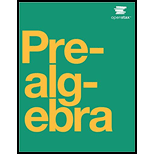
Bundle: Elementary Technical Mathematics, Loose-leaf Version, 12th + WebAssign Printed Access Card, Single-Term
12th Edition
ISBN: 9781337890199
Author: Dale Ewen
Publisher: Cengage Learning
expand_more
expand_more
format_list_bulleted
Concept explainers
Question
Chapter 16.8, Problem 45E
To determine
To calculate: The result of hexadecimal subtraction
Expert Solution & Answer
Want to see the full answer?
Check out a sample textbook solution
Students have asked these similar questions
Consider a vocabulary consisting of the nucleotide bases V = {A, T, G, C}.Construct a DFA to recognize strings which end in AAGT .(a) Draw the DFA with clear markings of all states including start and acceptance state(s).(b) Simulate the DFA to show that string T GAAGT will be accepted by the DFA.(c) Simulate the DFA to show that string T AAGT G will not be accepted by the DFA.
A palindrome is a string that reads the same backward as it does forward. For example, abaaaba is a palindrome. Suppose that we need to define a language that generates palindromes.(a) Define a phase structure grammar that generates the set of all palindromes over the alphabet {a, b}clearly describing the recursive rules that generates palindromes. Use the notation Symbol → rule. Theempty set is denoted by λ. Clearly identify the terminal and non-terminal symbols in your grammar.(b) Show that the palindrome abaaaba can be recognized by your grammar. To show this, show all stepsof parsing the expression abaaaba using the rules you defined above.
A full k-ary tree is a (rooted) tree whose nodes either have exactly k children (internal nodes) or have no children (leaves). Using structural induction, formally prove that every full k-ary tree that has x internal nodes has exactly kx + 1 nodes in total. Note that for full binary trees, i.e., when k = 2, this would imply that the total number of nodes is 2x + 1.
Chapter 16 Solutions
Bundle: Elementary Technical Mathematics, Loose-leaf Version, 12th + WebAssign Printed Access Card, Single-Term
Ch. 16.1 - Change each binary number to decimal form: 11Ch. 16.1 - Prob. 2ECh. 16.1 - Prob. 3ECh. 16.1 - Prob. 4ECh. 16.1 - Prob. 5ECh. 16.1 - Prob. 6ECh. 16.1 - Prob. 7ECh. 16.1 - Prob. 8ECh. 16.1 - Prob. 9ECh. 16.1 - Prob. 10E
Ch. 16.1 - Prob. 11ECh. 16.1 - Prob. 12ECh. 16.1 - Prob. 13ECh. 16.1 - Prob. 14ECh. 16.1 - Prob. 15ECh. 16.1 - Prob. 16ECh. 16.1 - Change each binary number to decimal form:...Ch. 16.1 - Prob. 18ECh. 16.1 - Change each binary number to decimal form: 111111Ch. 16.1 - Prob. 20ECh. 16.2 - Prob. 1ECh. 16.2 - Prob. 2ECh. 16.2 - Prob. 3ECh. 16.2 - Prob. 4ECh. 16.2 - Prob. 5ECh. 16.2 - Prob. 6ECh. 16.2 - Prob. 7ECh. 16.2 - Prob. 8ECh. 16.2 - Prob. 9ECh. 16.2 - Prob. 10ECh. 16.2 - Prob. 11ECh. 16.2 - Prob. 12ECh. 16.2 - Prob. 13ECh. 16.2 - Prob. 14ECh. 16.2 - Prob. 15ECh. 16.2 - Add the following binary numbers and check your...Ch. 16.2 - Prob. 17ECh. 16.2 - Prob. 18ECh. 16.2 - Prob. 19ECh. 16.2 - Prob. 20ECh. 16.2 - Prob. 21ECh. 16.2 - Prob. 22ECh. 16.2 - Prob. 23ECh. 16.2 - Add the following binary numbers and check your...Ch. 16.2 - Prob. 25ECh. 16.2 - Prob. 26ECh. 16.2 - Add the following binary numbers and check your...Ch. 16.2 - Prob. 28ECh. 16.2 - Prob. 29ECh. 16.2 - Prob. 30ECh. 16.3 - Prob. 1ECh. 16.3 - Prob. 2ECh. 16.3 - Subtract the following binary numbers and check in...Ch. 16.3 - Prob. 4ECh. 16.3 - Subtract the following binary numbers and check in...Ch. 16.3 - Subtract the following binary numbers and check in...Ch. 16.3 - Prob. 7ECh. 16.3 - Prob. 8ECh. 16.3 - Prob. 9ECh. 16.3 - Subtract the following binary numbers and check in...Ch. 16.3 - Subtract the following binary numbers and check in...Ch. 16.3 - Prob. 12ECh. 16.3 - Prob. 13ECh. 16.3 - Prob. 14ECh. 16.3 - Subtract the following binary numbers and check in...Ch. 16.3 - Prob. 16ECh. 16.3 - Prob. 17ECh. 16.3 - Subtract the following binary numbers and check in...Ch. 16.3 - Prob. 19ECh. 16.3 - Prob. 20ECh. 16.3 - Prob. 21ECh. 16.3 - Prob. 22ECh. 16.3 - Prob. 23ECh. 16.3 - Prob. 24ECh. 16.3 - Prob. 25ECh. 16.3 - Prob. 26ECh. 16.3 - Prob. 27ECh. 16.3 - Prob. 28ECh. 16.3 - Prob. 29ECh. 16.3 - Use the 1s complement method to subtract the...Ch. 16.3 - Prob. 31ECh. 16.3 - Prob. 32ECh. 16.3 - Prob. 33ECh. 16.3 - Prob. 34ECh. 16.3 - Prob. 35ECh. 16.3 - Prob. 36ECh. 16.4 - Prob. 1ECh. 16.4 - Prob. 2ECh. 16.4 - Multiply the following binary numbers: 11010_Ch. 16.4 - Prob. 4ECh. 16.4 - Prob. 5ECh. 16.4 - Prob. 6ECh. 16.4 - Prob. 7ECh. 16.4 - Prob. 8ECh. 16.4 - Prob. 9ECh. 16.4 - Prob. 10ECh. 16.4 - Prob. 11ECh. 16.4 - Prob. 12ECh. 16.4 - Prob. 13ECh. 16.4 - Multiply the following binary numbers: 101101101_Ch. 16.4 - Prob. 15ECh. 16.4 - Prob. 16ECh. 16.4 - Prob. 17ECh. 16.4 - Prob. 18ECh. 16.4 - Prob. 19ECh. 16.4 - Prob. 20ECh. 16.5 - Prob. 1ECh. 16.5 - Prob. 2ECh. 16.5 - Prob. 3ECh. 16.5 - Prob. 4ECh. 16.5 - Prob. 5ECh. 16.5 - Prob. 6ECh. 16.5 - Prob. 7ECh. 16.5 - Prob. 8ECh. 16.5 - Prob. 9ECh. 16.5 - Prob. 10ECh. 16.5 - Prob. 11ECh. 16.5 - Prob. 12ECh. 16.5 - Prob. 13ECh. 16.5 - Prob. 14ECh. 16.5 - Prob. 15ECh. 16.5 - Prob. 16ECh. 16.5 - Prob. 17ECh. 16.5 - Prob. 18ECh. 16.5 - Prob. 19ECh. 16.5 - Prob. 20ECh. 16.6 - Prob. 1ECh. 16.6 - Prob. 2ECh. 16.6 - Prob. 3ECh. 16.6 - Prob. 4ECh. 16.6 - Prob. 5ECh. 16.6 - Prob. 6ECh. 16.6 - Prob. 7ECh. 16.6 - Prob. 8ECh. 16.6 - Prob. 9ECh. 16.6 - Prob. 10ECh. 16.6 - Prob. 11ECh. 16.6 - Prob. 12ECh. 16.6 - Prob. 13ECh. 16.6 - Prob. 14ECh. 16.6 - Prob. 15ECh. 16.6 - Prob. 16ECh. 16.6 - Prob. 17ECh. 16.6 - Prob. 18ECh. 16.6 - Prob. 19ECh. 16.6 - Change each binary number to decimal form:...Ch. 16.7 - Prob. 1ECh. 16.7 - Prob. 2ECh. 16.7 - Prob. 3ECh. 16.7 - Prob. 4ECh. 16.7 - Prob. 5ECh. 16.7 - Prob. 6ECh. 16.7 - Prob. 7ECh. 16.7 - Prob. 8ECh. 16.7 - Prob. 9ECh. 16.7 - Prob. 10ECh. 16.7 - Prob. 11ECh. 16.7 - Prob. 12ECh. 16.7 - Prob. 13ECh. 16.7 - Change each hexadecimal number to decimal form:...Ch. 16.7 - Prob. 15ECh. 16.7 - Prob. 16ECh. 16.7 - Prob. 17ECh. 16.7 - Prob. 18ECh. 16.7 - Prob. 19ECh. 16.7 - Prob. 20ECh. 16.7 - Prob. 21ECh. 16.7 - Prob. 22ECh. 16.7 - Prob. 23ECh. 16.7 - Prob. 24ECh. 16.7 - Prob. 25ECh. 16.7 - Prob. 26ECh. 16.7 - Prob. 27ECh. 16.7 - Prob. 28ECh. 16.7 - Prob. 29ECh. 16.7 - Prob. 30ECh. 16.8 - Prob. 1ECh. 16.8 - Prob. 2ECh. 16.8 - Prob. 3ECh. 16.8 - Prob. 4ECh. 16.8 - Prob. 5ECh. 16.8 - Prob. 6ECh. 16.8 - Prob. 7ECh. 16.8 - Prob. 8ECh. 16.8 - Prob. 9ECh. 16.8 - Prob. 10ECh. 16.8 - Prob. 11ECh. 16.8 - Prob. 12ECh. 16.8 - Prob. 13ECh. 16.8 - Prob. 14ECh. 16.8 - Prob. 15ECh. 16.8 - Prob. 16ECh. 16.8 - Prob. 17ECh. 16.8 - Prob. 18ECh. 16.8 - Prob. 19ECh. 16.8 - Prob. 20ECh. 16.8 - Prob. 21ECh. 16.8 - Prob. 22ECh. 16.8 - Prob. 23ECh. 16.8 - Prob. 24ECh. 16.8 - Prob. 25ECh. 16.8 - Prob. 26ECh. 16.8 - Add the following hexadecimal numbers. Check using...Ch. 16.8 - Prob. 28ECh. 16.8 - Prob. 29ECh. 16.8 - Prob. 30ECh. 16.8 - Prob. 31ECh. 16.8 - Prob. 32ECh. 16.8 - Prob. 33ECh. 16.8 - Prob. 34ECh. 16.8 - Prob. 35ECh. 16.8 - Prob. 36ECh. 16.8 - Prob. 37ECh. 16.8 - Prob. 38ECh. 16.8 - Prob. 39ECh. 16.8 - Prob. 40ECh. 16.8 - Prob. 41ECh. 16.8 - Prob. 42ECh. 16.8 - Prob. 43ECh. 16.8 - Prob. 44ECh. 16.8 - Prob. 45ECh. 16.8 - Prob. 46ECh. 16.8 - Prob. 47ECh. 16.8 - Prob. 48ECh. 16.8 - Prob. 49ECh. 16.8 - Prob. 50ECh. 16.8 - Prob. 51ECh. 16.8 - Prob. 52ECh. 16.8 - Prob. 53ECh. 16.8 - Prob. 54ECh. 16.8 - Prob. 55ECh. 16.8 - Prob. 56ECh. 16.8 - Prob. 57ECh. 16.8 - Prob. 58ECh. 16.8 - Prob. 59ECh. 16.8 - Prob. 60ECh. 16.9 - Prob. 1ECh. 16.9 - Prob. 2ECh. 16.9 - Prob. 3ECh. 16.9 - Prob. 4ECh. 16.9 - Prob. 5ECh. 16.9 - Prob. 6ECh. 16.9 - Prob. 7ECh. 16.9 - Prob. 8ECh. 16.9 - Prob. 9ECh. 16.9 - Prob. 10ECh. 16.9 - Prob. 11ECh. 16.9 - Prob. 12ECh. 16.9 - Prob. 13ECh. 16.9 - Prob. 14ECh. 16.9 - Prob. 15ECh. 16.9 - Prob. 16ECh. 16.9 - Prob. 17ECh. 16.9 - Prob. 18ECh. 16.9 - Prob. 19ECh. 16.9 - Prob. 20ECh. 16.9 - Prob. 21ECh. 16.9 - Prob. 22ECh. 16.9 - Prob. 23ECh. 16.9 - Change each binary number to hexadecimal form:...Ch. 16.9 - Prob. 25ECh. 16.9 - Prob. 26ECh. 16.9 - Prob. 27ECh. 16.9 - Prob. 28ECh. 16.9 - Prob. 29ECh. 16.9 - Prob. 30ECh. 16.9 - Prob. 31ECh. 16.9 - Prob. 32ECh. 16.9 - Prob. 33ECh. 16.9 - Prob. 34ECh. 16.9 - Prob. 35ECh. 16.9 - Prob. 36ECh. 16.9 - Prob. 37ECh. 16.9 - Prob. 38ECh. 16.9 - Prob. 39ECh. 16.9 - Prob. 40ECh. 16.9 - Prob. 41ECh. 16.9 - Prob. 42ECh. 16.9 - Prob. 43ECh. 16.9 - Prob. 44ECh. 16 - Prob. 1RCh. 16 - Prob. 2RCh. 16 - Prob. 3RCh. 16 - Prob. 4RCh. 16 - Prob. 5RCh. 16 - Prob. 6RCh. 16 - Add the following binary numbers: 1001110101_Ch. 16 - Prob. 8RCh. 16 - Prob. 9RCh. 16 - Prob. 10RCh. 16 - Prob. 11RCh. 16 - Prob. 12RCh. 16 - Prob. 13RCh. 16 - Prob. 14RCh. 16 - Prob. 15RCh. 16 - Prob. 16RCh. 16 - Prob. 17RCh. 16 - Prob. 18RCh. 16 - Prob. 19RCh. 16 - Prob. 20RCh. 16 - Prob. 21RCh. 16 - Prob. 22RCh. 16 - Prob. 23RCh. 16 - Prob. 24RCh. 16 - Prob. 25RCh. 16 - Prob. 26RCh. 16 - Prob. 27RCh. 16 - Prob. 28RCh. 16 - Prob. 29RCh. 16 - Prob. 30RCh. 16 - Prob. 1TCh. 16 - Prob. 2TCh. 16 - Prob. 3TCh. 16 - Prob. 4TCh. 16 - Prob. 5TCh. 16 - Prob. 6TCh. 16 - Prob. 7TCh. 16 - Prob. 8TCh. 16 - Prob. 9TCh. 16 - Prob. 10TCh. 16 - Prob. 11TCh. 16 - Prob. 12TCh. 16 - Prob. 13TCh. 16 - Prob. 14TCh. 16 - Prob. 15TCh. 16 - Prob. 16TCh. 16 - Prob. 17TCh. 16 - Prob. 18TCh. 16 - Prob. 19TCh. 16 - Prob. 20TCh. 16 - Prob. 1CRCh. 16 - Prob. 2CRCh. 16 - Prob. 3CRCh. 16 - Prob. 4CRCh. 16 - Prob. 5CRCh. 16 - Prob. 6CRCh. 16 - Prob. 7CRCh. 16 - Prob. 8CRCh. 16 - Prob. 9CRCh. 16 - Prob. 10CRCh. 16 - Prob. 11CRCh. 16 - Prob. 12CRCh. 16 - Prob. 13CRCh. 16 - Prob. 14CRCh. 16 - Prob. 15CRCh. 16 - Prob. 16CRCh. 16 - Prob. 17CRCh. 16 - Prob. 18CRCh. 16 - Prob. 19CRCh. 16 - Prob. 20CRCh. 16 - Prob. 21CRCh. 16 - Prob. 22CRCh. 16 - Prob. 23CRCh. 16 - Prob. 24CRCh. 16 - Do as indicated for the following binary numbers:...Ch. 16 - Prob. 26CRCh. 16 - Prob. 27CRCh. 16 - Prob. 28CRCh. 16 - Prob. 29CRCh. 16 - Prob. 30CR
Knowledge Booster
Learn more about
Need a deep-dive on the concept behind this application? Look no further. Learn more about this topic, subject and related others by exploring similar questions and additional content below.Similar questions
- question 10 pleasearrow_forward00 (a) Starting with the geometric series Σ X^, find the sum of the series n = 0 00 Σηχη - 1, |x| < 1. n = 1 (b) Find the sum of each of the following series. 00 Σnx", n = 1 |x| < 1 (ii) n = 1 sin (c) Find the sum of each of the following series. (i) 00 Σn(n-1)x^, |x| <1 n = 2 (ii) 00 n = 2 n² - n 4n (iii) M8 n = 1 շոarrow_forward(a) Use differentiation to find a power series representation for 1 f(x) = (4 + x)²* f(x) = 00 Σ n = 0 What is the radius of convergence, R? R = (b) Use part (a) to find a power series for f(x) = 1 (4 + x)³° f(x) = 00 Σ n = 0 What is the radius of convergence, R? R = (c) Use part (b) to find a power series for f(x) = x² (4 + x)³* 00 f(x) = Σ n = 2 What is the radius of convergence, R? R = Need Help? Read It Watch It SUBMIT ANSWERarrow_forward
- W AutoSave Off Soal Latihan Matdis (1) ▼ Search File Home Insert Draw Design Layout References Mailings Review View Help Aptos (Body) ✓ 12 A A Aa Ро Paste BI U ab x, x² A ✓ A ད Clipboard ₪ 24 23 22 21 20 19 18 17 16 15 1″ ידידיו Page 1 of 1 25°C 215 words Berawan E> M Font 四 Paragraph 3 4 1 56 ☑ 781 LI Comments Editing Find ✓ Normal No Spacing Heading Replace Add-ins Select Styles ☑ Editing Add-ins 91 10 111 12 | 13| 14 15 5. Suppose you wanted to draw a quadrilateral using the dots below as vertices (corners). The dots are spaced one unit apart horizontally and two units apart vertically. a) How many quadrilaterals are possible? b) How many are squares? How many are rectangles? c) How many are parallelograms? English (Indonesia) Accessibility: Investigate R - W ☑ Share ▾ Focus + 100% 00:17 13/04/2025arrow_forwardanswer for question 4 pleasearrow_forwardThe joint density function of two continuous random variables X and Y is: p(x, y) = {Kcos(x + y) Find (i) the constant K 0 0arrow_forwardp(x,y) = {e-x -(x+y) 0 x ≥ 0, y ≥ 0 otherwise find x,y,Exy, by Охarrow_forward2. Show that 8 xa S -dx (b² + 12) dr = 2 cos(π2) пра-1 a, b real and -1 0 Your solution should clearly explain the closed contour you are using, and state clearly any vanishing properties of integrals over contours that are being used. You are free to quote from the lectures, the appropriate results on such vanishing properties, without deriving these properties. Any residue calculations involved should be explained clearly.arrow_forwardCould you please answer this question using excel.Thanksarrow_forward1. Calculate the integral 500 x sin x (a² +x2)20 dx by using the residue theorem. You may assume that a is real and a > 0. Your solution should clearly explain the closed contour you are using, and state clearly any vanishing properties of integrals over contours that are being used.arrow_forwardQuestions An insurance company's cumulative incurred claims for the last 5 accident years are given in the following table: Development Year Accident Year 0 2018 1 2 3 4 245 267 274 289 292 2019 255 276 288 294 2020 265 283 292 2021 263 278 2022 271 It can be assumed that claims are fully run off after 4 years. The premiums received for each year are: Accident Year Premium 2018 306 2019 312 2020 318 2021 326 2022 330 You do not need to make any allowance for inflation. 1. (a) Calculate the reserve at the end of 2022 using the basic chain ladder method. (b) Calculate the reserve at the end of 2022 using the Bornhuetter-Ferguson method. 2. Comment on the differences in the reserves produced by the methods in Part 1.arrow_forwardCalculate the correlation coefficient r, letting Row 1 represent the x-values and Row 2 the y-values. Then calculate it again, letting Row 2 represent the x-values and Row 1 the y-values. What effect does switching the variables have on r? Row 1 Row 2 13 149 25 36 41 60 62 78 S 205 122 195 173 133 197 24 Calculate the correlation coefficient r, letting Row 1 represent the x-values and Row 2 the y-values. r=0.164 (Round to three decimal places as needed.) S 24arrow_forwardarrow_back_iosSEE MORE QUESTIONSarrow_forward_ios
Recommended textbooks for you
 Mathematics For Machine TechnologyAdvanced MathISBN:9781337798310Author:Peterson, John.Publisher:Cengage Learning,
Mathematics For Machine TechnologyAdvanced MathISBN:9781337798310Author:Peterson, John.Publisher:Cengage Learning, Elementary AlgebraAlgebraISBN:9780998625713Author:Lynn Marecek, MaryAnne Anthony-SmithPublisher:OpenStax - Rice University
Elementary AlgebraAlgebraISBN:9780998625713Author:Lynn Marecek, MaryAnne Anthony-SmithPublisher:OpenStax - Rice University Holt Mcdougal Larson Pre-algebra: Student Edition...AlgebraISBN:9780547587776Author:HOLT MCDOUGALPublisher:HOLT MCDOUGAL
Holt Mcdougal Larson Pre-algebra: Student Edition...AlgebraISBN:9780547587776Author:HOLT MCDOUGALPublisher:HOLT MCDOUGAL Algebra: Structure And Method, Book 1AlgebraISBN:9780395977224Author:Richard G. Brown, Mary P. Dolciani, Robert H. Sorgenfrey, William L. ColePublisher:McDougal Littell
Algebra: Structure And Method, Book 1AlgebraISBN:9780395977224Author:Richard G. Brown, Mary P. Dolciani, Robert H. Sorgenfrey, William L. ColePublisher:McDougal Littell

Mathematics For Machine Technology
Advanced Math
ISBN:9781337798310
Author:Peterson, John.
Publisher:Cengage Learning,

Elementary Algebra
Algebra
ISBN:9780998625713
Author:Lynn Marecek, MaryAnne Anthony-Smith
Publisher:OpenStax - Rice University

Holt Mcdougal Larson Pre-algebra: Student Edition...
Algebra
ISBN:9780547587776
Author:HOLT MCDOUGAL
Publisher:HOLT MCDOUGAL

Algebra: Structure And Method, Book 1
Algebra
ISBN:9780395977224
Author:Richard G. Brown, Mary P. Dolciani, Robert H. Sorgenfrey, William L. Cole
Publisher:McDougal Littell

ALGEBRAIC EXPRESSIONS & EQUATIONS | GRADE 6; Author: SheenaDoria;https://www.youtube.com/watch?v=fUOdon3y1hU;License: Standard YouTube License, CC-BY
Algebraic Expression And Manipulation For O Level; Author: Maths Solution;https://www.youtube.com/watch?v=MhTyodgnzNM;License: Standard YouTube License, CC-BY
Algebra for Beginners | Basics of Algebra; Author: Geek's Lesson;https://www.youtube.com/watch?v=PVoTRu3p6ug;License: Standard YouTube License, CC-BY
Introduction to Algebra | Algebra for Beginners | Math | LetsTute; Author: Let'stute;https://www.youtube.com/watch?v=VqfeXMinM0U;License: Standard YouTube License, CC-BY